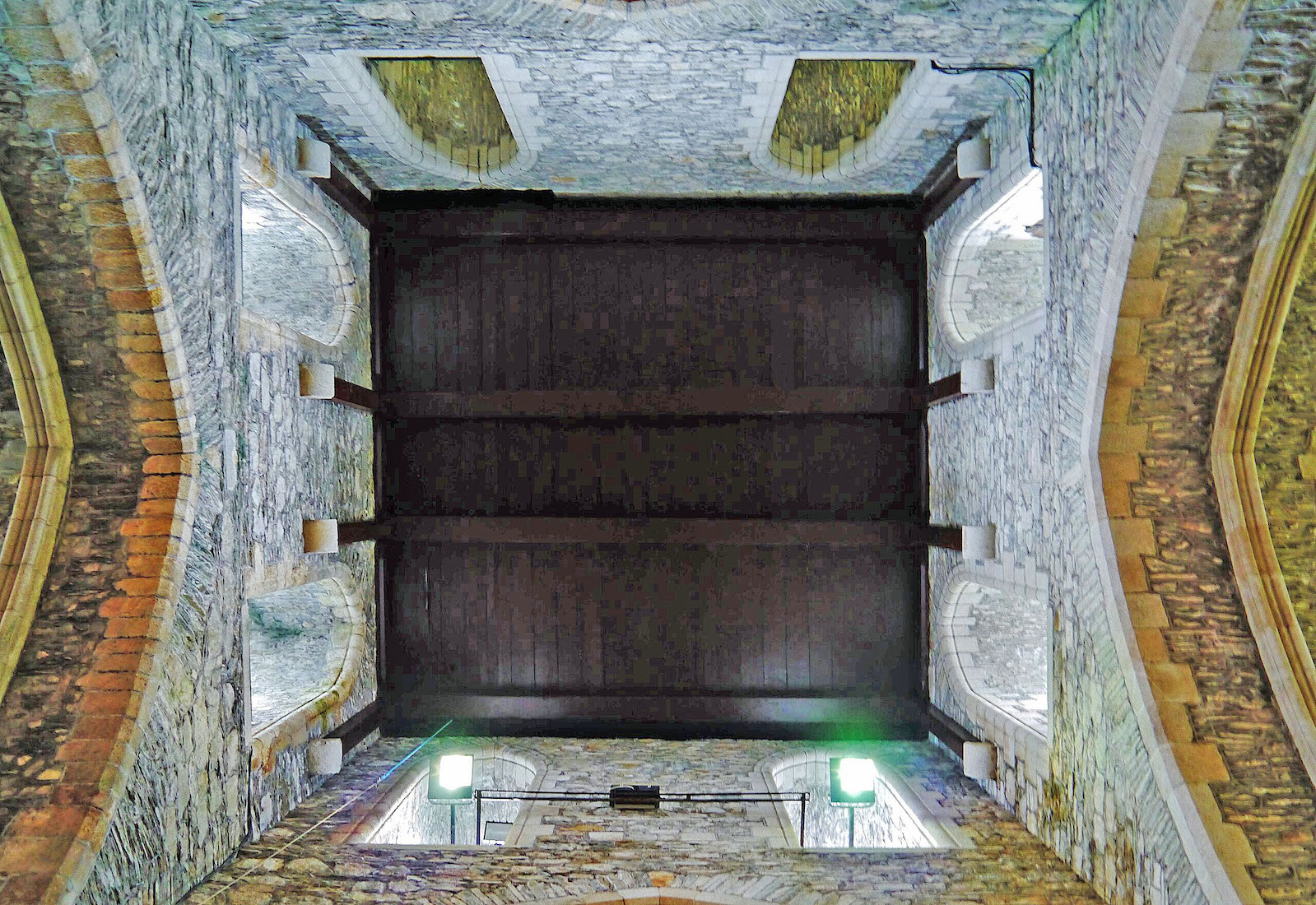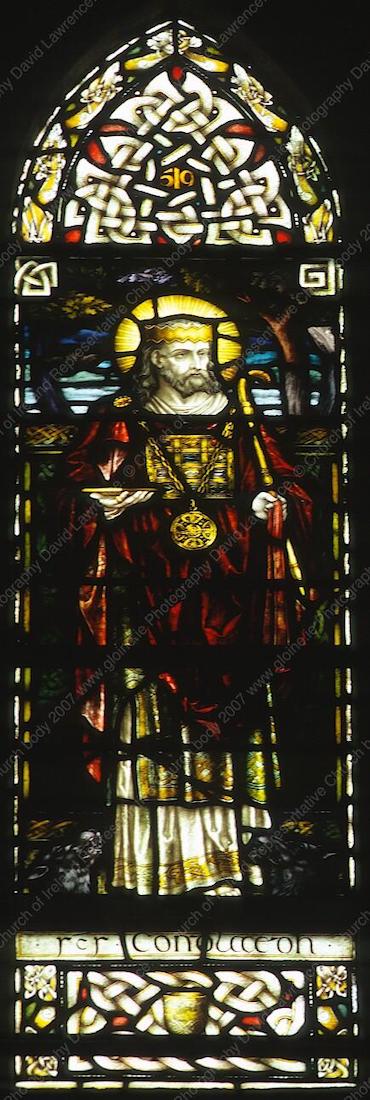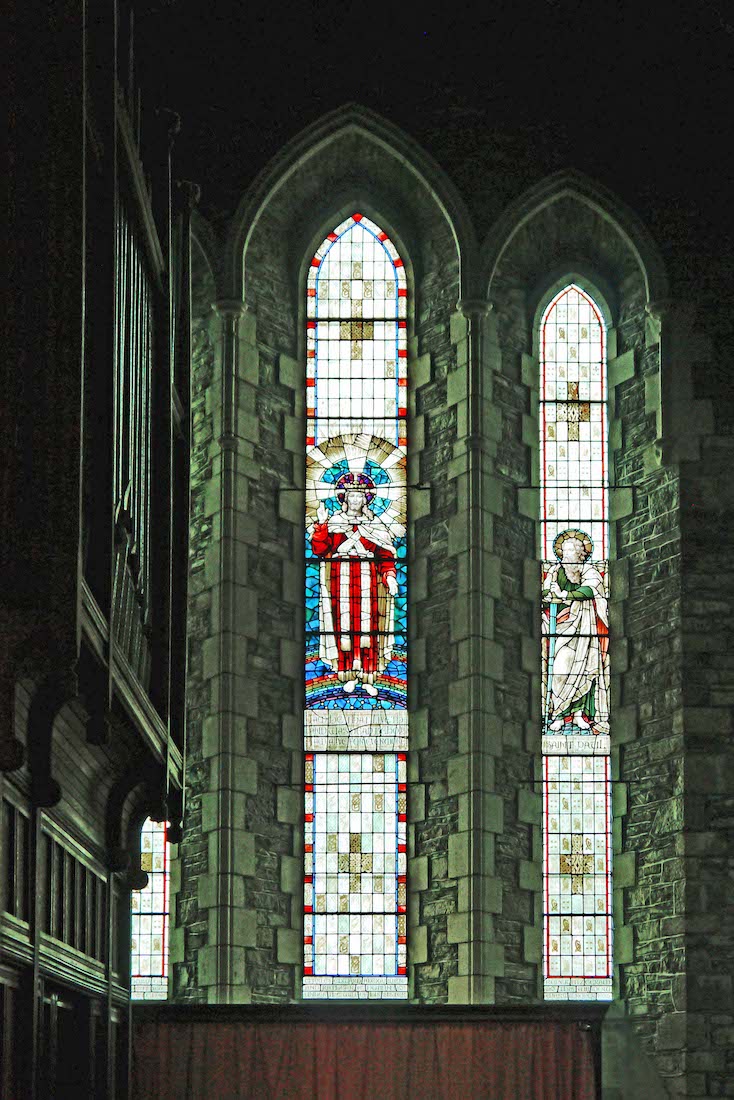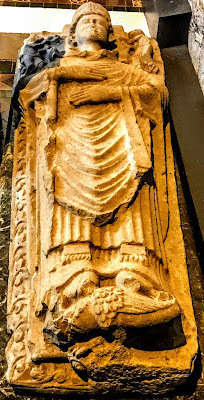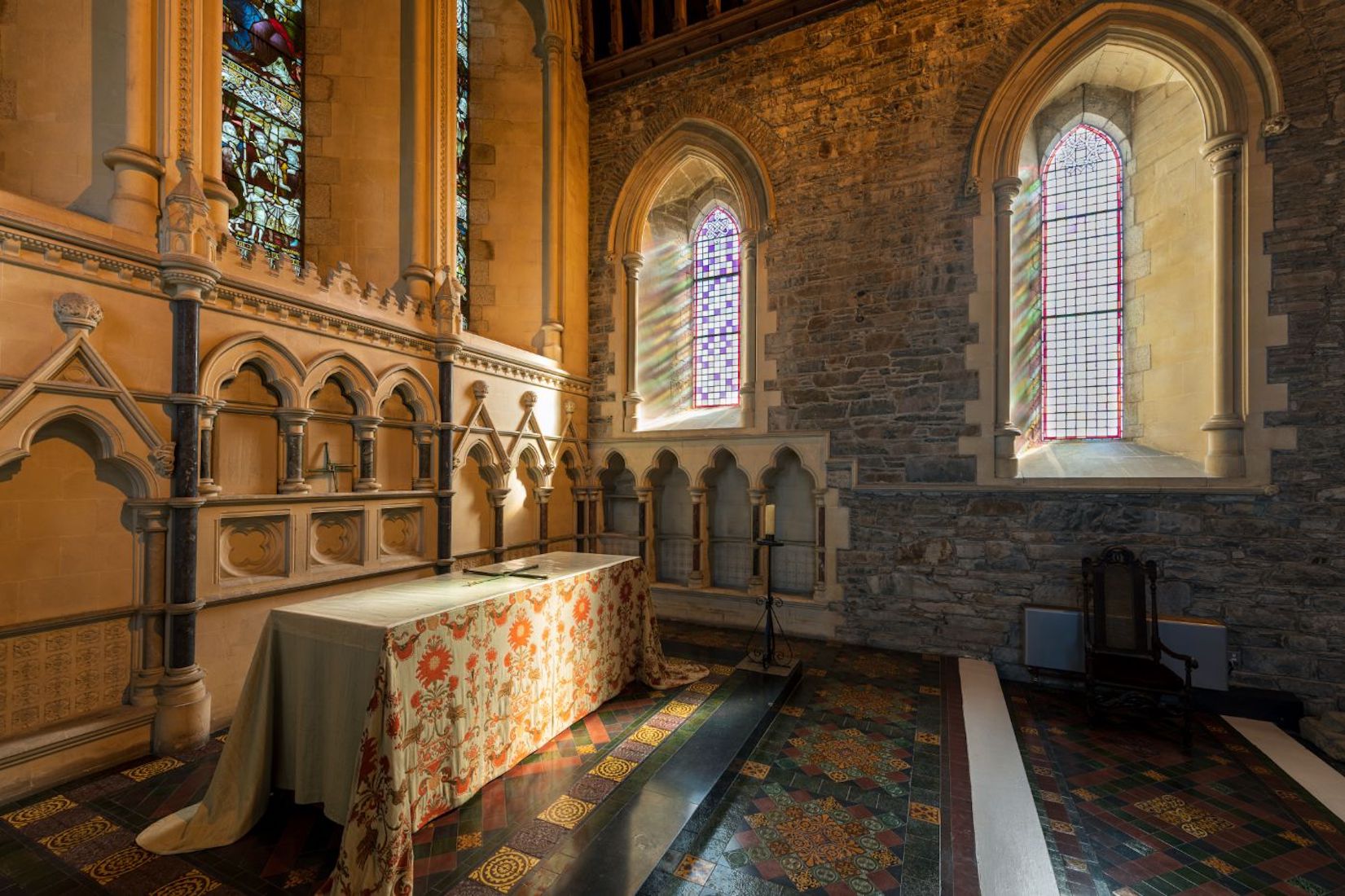21. NORTH NAVE WINDOWS Gl Gl Gl


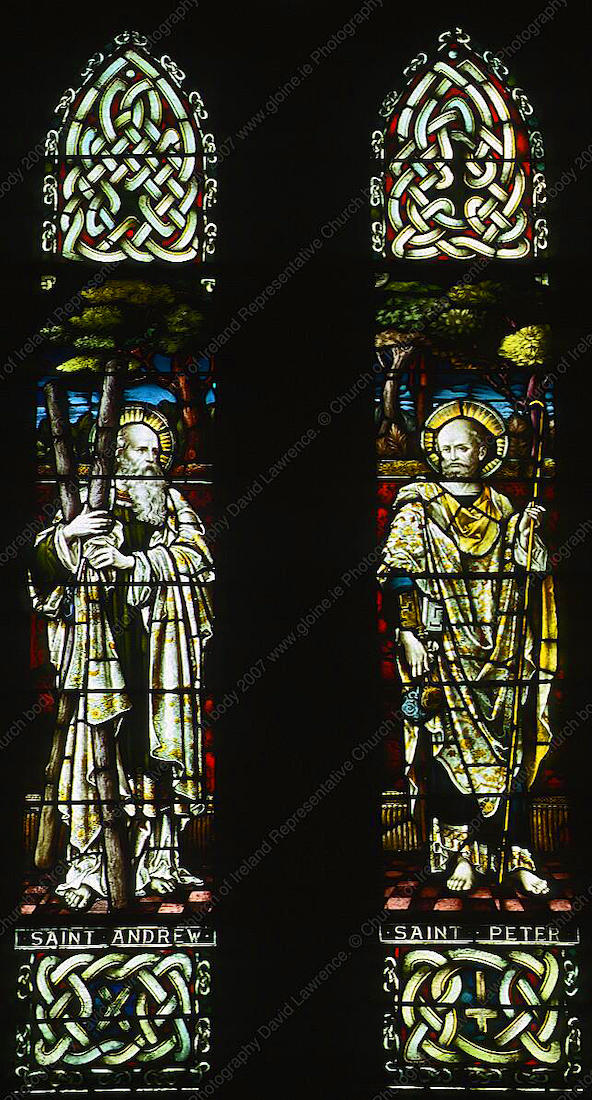
There are three windows in the North nave wall, shown here from West to East. They depict: •• St John the Divine (Watson and Co., Youghal, 1919); •• St John the Baptist, with a scene of his beheading at Herod’s command (A.L. Moore and Co., London, 1903); •• and the pair of lancets showing St Andrew and St Peter (Heaton, Butler and Bayne, 1915). Depictions of St Andrew can usually be recognised by the diagonal cross on which he was crucified, and St Peter by the Keys of the Kingdom which he carries. INDEX
22. SOUTH NAVE WINDOWS Gl Gl Gl



There are three stained glass window in th South wall of the nave, shown here from East to West. They show: •• St Patrick and St Columba (Heaton, Butler & Bayne, London, 1897); •• St Finnian of Moville (Watson & Co., Youghal, 1916) ; •• St Luke (Cerda Schliemann, c.1973) . Finnian of Movilla (c 495 – 589) was an Irish Christian missionary.
23. WAR MEMORIAL IWM
This monument on the South nave wall remembers local man George Herbert Medlicott who was killed in action in France in 1916 aged 31 years. [Photo Credit: Irish War Memorials]
24. PULPIT AND LECTERN PM AFB
Coming to the front of the nave, we have the pulpit at left and the lectern at right. •• The pulpit is from where the Gospel is preached each week. This pulpit is made of carved Caen stone with Irish marble columns. •• The lectern holds the Bible for the weekly scripture readings. This lectern has the standard brass eagle design. Photo Credit: Andreas F. Borchert]
25. CROSSING CEILING W-z
Standing in the crossing we can look up to see the plain timber ceiling up inside the tower. Technically this would be called a cathedral ‘lantern’. Two of the arches hold stained glass windows. [Photo Credit: Wikimedia zairon]
26. HIGH CROSSING WINDOWS Gl AFB Gl
High in the Eastern wall of the tower are two stained glass windows. These show St Brigid at left and St Conleth at right. •• Brigid is informally recognised as a saint in no less than three Christian religions, Roman Catholicism, the Anglican communion, and Eastern Orthodox Catholicism. But the devil is in the word ‘informally’ because in 1969 she, along with dozens of other virtuous early Christians, had her name expunged from the list of saints by the Vatican. No reason given! •• Saint Conleth was an Irish hermit and metalworker, also said to have been a copyist and skilled illuminator of manuscripts. He is believed to have come from the Wicklow area. [Photo2 Credit: Andreas F. Borchert]
28. ORGAN SBC
St Brigid’s Cathedral has a celebrated three-manual Conagher organ built in 1896. In recent years the Kildare Choral and Organ Festival has taken place in the Cathedral. •• In 1896 the organ was assembled in the workshop of organ builder Peter Conacher, in Huddersfield, West Yorkshire, England, at a cost of £600. The organ was dissembled in order for it to be transported to the Cathedral of Kildare. It was then reassembled and placed in the South transept. It was originally a two manual instrument. Around that time, Peter Conacher also built four other organs that were installed in this general area. In 1934 a third manual was added (the Choir Organ), and it was reassembled. There was a major restoration of the organ from 2005 to 2010, at a cost of €120,000. The work was carried out by the renowned Irish organ builder, Trevor Crowe. It was one of the successful restorations carried out in recent times in Ireland.
29. NORTH TRANSEPT NORTH WINDOW GSV SBC
The North transept window has three lancets, depicting the glorified Christ at centre, with St Peter and St Paul on either side. The window was created by Heaton, Butler & Bayne, London in 1935. It is documented that the head of Christ in the central panel is an intrusion, executed in a different style. See here.
30. SOUTH TRANSEPT SBC
A high view of the South transept. We see the interior porch which covers this entry to the Cathedral. The transept houses a small collection of late medieval sculptural monuments ranging in date. The finest of these monuments is the tomb of Bishop Wellesley who died in 1539. We might also note the Wellesley tomb next to the porch, and an effigy lying on the floor under the far window.
31. SOUTH TRANSEPT AND RALPH EFFIGY GW PC
The effigy under the transept window is thought to be that of Bishop Ralph of Bristol. Between the years 835 and 998 the Cathedral was devastated approximately 16 times, so that when the Norman, Ralph of Bristol, became bishop in 1223 it was virtually in ruins. Between then and 1230 it was largely rebuilt, likely in the years following 1223, and probably by Ralph of Bristol who was made Bishop of the see in 1222 and died in 1232. [Photo1 Credit: GSV Gerry Walsh; Photo2 Credit; PC]
32. SAMUEL AND TIMOTHY Gl Gl
On the Western wall of the South transept is a two-lancet window depicting Samuel and Timothy. They were produced in 1915 by Heaton, Butler & Bayne, London, 1915, and together they form the R.S. Chaplin window. The window is a memorial to Revd R.S. Chaplin who, as a young boy in 1871, gave the first subscription to the work of restoration of the Cathedral.
33. WELLESLEY TOMB AFB
Wellesley was prior of the Augustinian Abbey of Great Connell close to the preset day town of Newbridge, and was appointed Bishop of Kildare in 1529. The tomb, which was originally in Great Connell, was relocated to Kildare Cathedral in 1971 in order to ensure it's conservation. Despite the damage suffered over the centuries prior to it's relocation, the tomb is considered to be one of the finest examples of a 16th century sculptural altar tomb still in existence in Ireland. The top of the tomb has a carved effigy of Bishop Wellesley. [Photo Credit: Andreas F. Borchert]
34. DETAILS OF WELLESLEY TOMB AFB AFB PC AKD
Shown here are various apostles and saints depicted on the front of the tomb. We can pick St Peter! Each vertical end of the tomb has scenes form the New Testament; the South end is Ecce Homo, (Christ bound before Pilate) – not shown here, and the North end is the Crucifixion. •• The tomb is also unusual in that it has, hidden under the lip of the top, a carved sheelagh-na-gig. (This is a type of stone architectural figure of uncertain significance, representing a naked woman gesturing to or otherwise flagrantly displaying exaggerated genitalia.) [Photo1 Credit: Andreas F. Borchert; Photo2 Credit: Andreas F Borchert; Photo3 Credit: Patrick Comerford; Photo4 Credit: Wikimedia A. -K. D.]
35. WEST VIEW SBC
We leave the South transept and move to the sanctuary. Looking to the far West window, we see the pulpit to our right, and to our left the cathedra.
36. CATHEDRA PM
The cathedra is the Bishop’s throne. The Latin word for seat is ‘cathedra’, and it is from here we get the name ‘cathedra’, and so ‘cathedral’. So, a cathedral is a church which houses a cathedra. It signifies that this is the primary church in the local diocese.
37. SANCTUARY, ALTAR SBC
At the East end of the sanctuary we find a modest high altar, and above it the East window. The built-in seats in the far wall are called sedilia : I suspect they are never used! The windows in the far wall are interesting because they show what the ‘clear’ windows in the Cathedral look like.
38. EAST WINDOW Gl
Our final image of this Cathedral is the East window. There are five scenes depicted here: (Left lower) Moses and the Gathering of the Manna; •• (Left upper) Christ Healing the two Blind Men; •• (Centre lower) Moses and the First Passover; •• (Centre upper)Supper at Emmaus; •• (Right lower) Moses striking the Rock •• (Right upper) Ascension. The window was produced by Heaton, Butler & Bayne, London) in 1891.

CONCLUSION W-C
I hope you have enjoyed visiting St Brigid’s Cathedral in Kildare with me. It is simple in its layout and design, yet perhaps its charm lies in that simplicity.
The photographs on this site come from many sources. Where there only one or two from a given source, these are acknowledged in the text. Where there are multiple contributions, these are acknowledged by initials in the text, and in more detail here as follows:
Gl : Gloine. These are the window photos, and are found on the gloine site.
GSV : Google Street View. Google Maps takes us around the outside of St Brigid’s. These photos are screenshots from here.
PM : Paul McNamara. These photos can be found on Paul’s Flickr site.
SBC: St Brigid’s Cathedral. These are photos from the Cathedral site https://stbrigidscathedral.com/inside-the-cathedral/
I take little credit for the text which comes from a variety of different sources, including Wikipedia. I also express my thanks to my wife Margie who dutifully reads through all my websites and checks the typing.
I would be glad to receive any comments, criticisms or corrections to this site. The best websites are those which contain no errors!
Kildare Cathedral has its own website:
https://stbrigidscathedral.com
Site created 05 / 2024
Paul Scott




